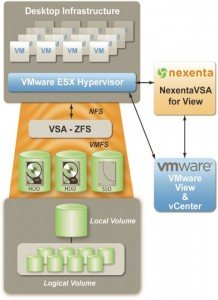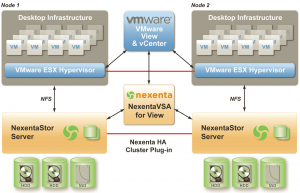NexentaVSA for View (NV4V) is a solution developed by Nexenta, with the collaboration also of VMware, that implement an integrated virtual storage solution for VMware View deployments and provides a interesting approach to VDI implementation.
It tried to solve most of the possible issues or disadvantages of a VDI approach:
- Performance: in common VDI environment the storage could become the bottleneck of the infrastructure, with this solution you can simple scale by adding new hosts (in the same way on how you can scale to add more computational power).
- Cost: it remove the need of a centralized storage (that usually must also have some high level functions to be useful in a VDI environment).
- Complexity: simplifies the complexities of storage and desktop deployment for VDI into one console, greatly streamlining the process.
- Monitoring: while allowing for in-depth analytics, performance testing, and VDI environment calibration.
Basically it integrates a management part (the NexentaVSA for View) with a storage part that could be:
- Local and one for each hosts: by using the NexentaStor VSA
- Shared (as a common shared storage): by using an solution based on NexentaStor Server
About the trade-off between a local or a shared storage approach, see this previous post. The local approach could be the prefered for this kind of product. Also with the power of the new server’s generations (were you can have in only 2U more than 16 cores, more than 1 TB of RAM, more that 20 slots for a 2.5″ HD) each single node could become a complete “building block” in a View design.
With a good VDI design, especially in pool design and user status management, you can move to a local storage approach that could become an interesting way to build a scale-out solution where the gap between VMs and storage is smaller (for more info about those concept see this post). Of course is also a multi-tiering solution to guarantee better performance.
But note that local and scale-out, does not imply that this solution build a single logical, transparent and redundant storage layer (for example as Nutanix does): each local storage is just “local” and if you loose a host you loose the VMs and the data. For this reason you must design well your View pools and also how the user profile is handles. Of course, some data, like the golden image, the user profiles, the View Connections Servers, must reside on a storage with high availability or with a good level of data protection. For user profiles could be not a big problem: a good fileserver is a common solution (and a low cost approach could be implement it with Microsoft DFS+FRS). For the View Connection Server a replica configuration could be an alternative way to provide high availability and also load balancing.
The other solution is use the shared storage approach, but (from my of view) you may loose most of the advantages of NexentaVSA for View.
Also note that the storage part is only one of feature of this product (probably the most important and the most relevant, but not the only one!). The management and monitor part are also interesting, considering that we are talking about a 1.0 version.
For more information see:
Next posts:













